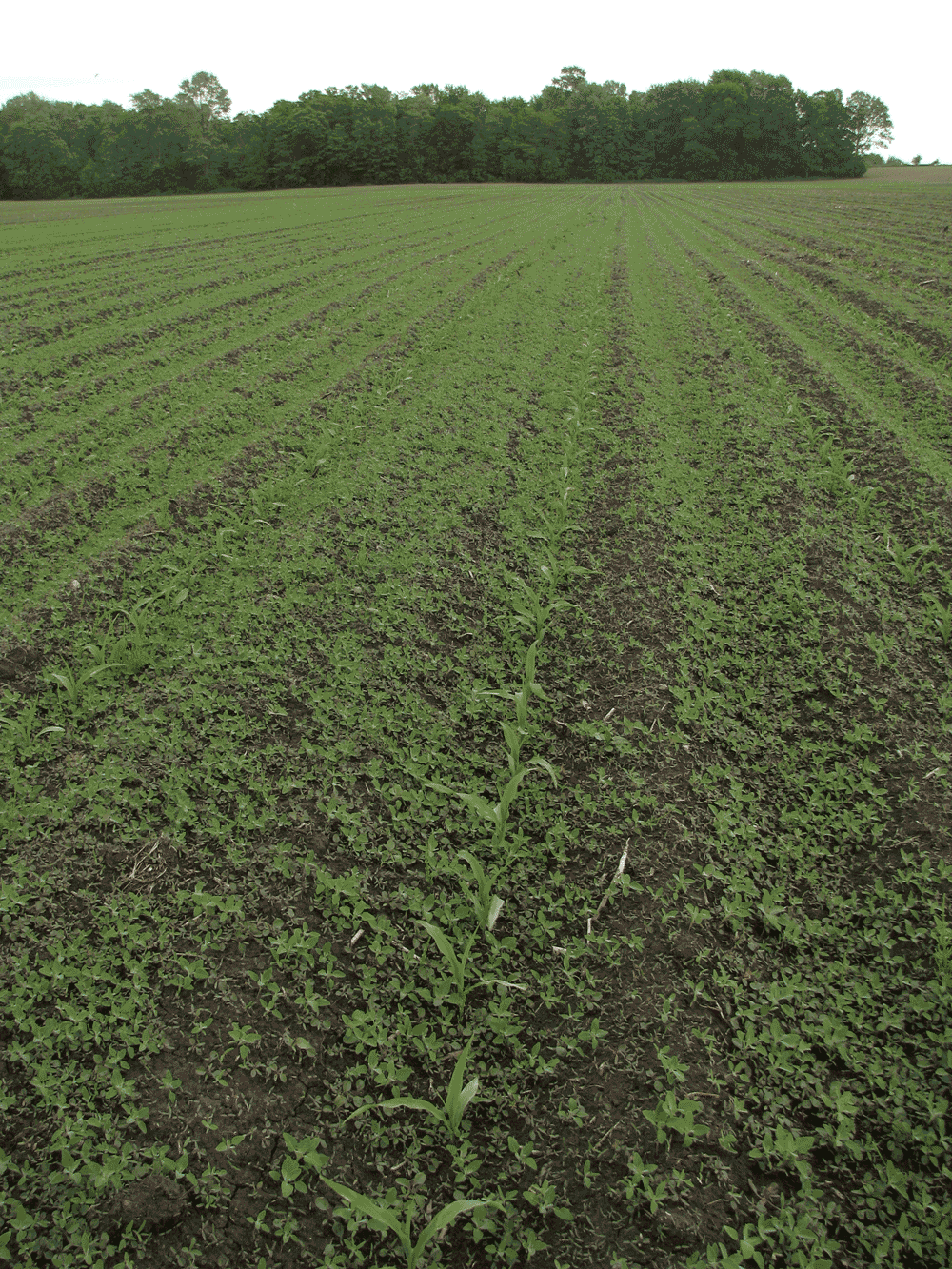Owning the problem
TAKING PROACTIVE STEPS AGAINST HERBICIDE RESISTANCE
from his office on campus at the University of Guelph, Plant Agriculture professor and weed scientist Francois Tardif is poring over slides showing examples of resistant weeds found on farms in the southern United States.
One pigweed plant takes up the entire bed of a farmer’s pickup truck. Another slide shows a soybean field completely dwarfed by giant ragweed.
Weed resistance is spreading rapidly to fields across Ontario with each passing season. Leading weed researchers and experts all agree that Ontario growers need to own the resistance problem now, and take proactive steps before it threatens their livelihood.
Weeds thrive on routine. Growers using the exact same herbicides year after year are at the highest risk of having resistant weeds develop. However, resistance isn’t something that happens overnight.
Leading weed researchers say that it can take several growing seasons before farmers realize that they have a serious resistance problem. And by then, it is a matter of months, as resistant weed seeds spread and overwhelm an entire crop.
the current situation
New statistics show 82 confirmed sites of resistant giant ragweed in Ontario. Since 2008, an average of 20 new resistant giant ragweed cases have been reported each year. Glyphosate-resistant Canada fleabane has been found in 155 fields – up from eight fields just three years ago. There is also one field in Essex County with glyphosate resistant common ragweed.
Even more worrying – nineteen sites of Canada fleabane and five sites of giant ragweed biotypes with multiple resistance to glyphosate and FirstRate™ have been reported in Essex, Kent, Lambton, Elgin and Middlesex counties.
Tardif, who has been researching herbicide resistance since 1991 and serves on the Ontario Weed Committee, believes the root causes are a mix of plant biology and human behaviour.
On the biology side, weeds constantly find new ways to survive and thrive in even the harshest growing environments. They will gradually alter their own genetic structures to neutralize chemicals that may have killed them a few growing seasons before.
On the human behaviour side, producers have relied far too much on the same herbicide treatments to get the job done year after year.
“It’s just human nature when you have something like glyphosate that works really well and is economical, you’re going to keep using it until it doesn’t work,” says Tardif.
Researchers have been working on resistance for decades. Right now, Tardif says Ontario farmers are currently in what he calls the “third wave” of herbicide resistance.
history of herbicides
Tardif credits the Second World War with ushering in modern herbicides as we know them today. During the War, Allied scientists developed new herbicides that could be used to destroy enemy crops. When the War ended, the herbicides were eventually licensed to commercial chemical companies and put into mass production.
One of these products was 2,4-D, which became a widely used herbicide in fields across North America.
“As early as the 1950’s, you start to hear biologists warning that resistance could happen if growers continued using the same weed control measures each season,” explains Tardif. “And yes, there were a few small pockets of resistance in the United States and Canada, but they were seen as more of a curiosity.”
Tardif says the issue wasn’t acknowledged until the 1970’s, when weeds resistant to Atrazine became a serious issue in corn production – the so-called “first wave” of resistance. The “second wave” of resistance would strike in the early 1990’s with Group 2 resistant weeds. Though, this time, breakthroughs in glyphosate-resistant Roundup Ready® crops rode to the rescue – for a while, at least.
be proactive not reactive
Kristen Callow, who leads the Ontario Ministry of Agriculture and Food’s Weed Management Program in horticulture, says that, up until now, most of the resistance management in Ontario has been reactive, rather than proactive.
PHOTO: A FIELD OF CORN AT THE 4 LEAF STAGE WITH LAMBS QUARTERS AND PIGWEED.

“I would say right now that we’re buying some time and kind of preventing the issue from getting worse,” Callow says. “But if the growers do not have proactive management, it’s eventually going to cost them their crop – bottom line.”
Callow explains that depending on the weed species, each plant can produce anywhere from 250 to one million seeds per plant. And depending on the species’ genetics, a good chunk or even all of those weed seeds can be resistant. Machinery, such as tillage equipment and combines, and wind tend to be the main culprits for distributing weed seeds from field to field.
Callow says producers should look at integrated weed management strategies, such as crop rotations and tank mixes, rather than a new miracle product to guard against resistance.
According to Kate Hyatt, a technical support representative with Bayer CropScience, that miracle product won’t be coming any time soon.
“I don’t know whether we’ll ever see another glyphosate,” says Hyatt. “Believe me – if we could find a ‘cure all’ solution to solve resistance and introduce it in a responsible way, I think any company would do that. But there is no quick-fix solution right now.”
Instead, Hyatt says information may be the greatest weapon a producer has against resistance.
In the last four months, Bayer has launched MixItUp.ca, a website that offers growers management strategies, alternative chemical mixtures, a weekly updated resistance news feed and a map on where resistant weed sites have been reported across the province.
“There are so many herbicide resistance tools out there and we want to bring those pieces together to give producers a resource going forward,” says Hyatt.
For Tardif, managing resistance going forward requires a mass buy-in from growers, grower groups and industry. On a farm level, growers need to own the problem by using more proactive weed programs that may mean paying more per acre upfront, but will buy them time against the spread of resistant weeds.
“Resistance is a concern, and farmers are going to hear a lot of different messages – some doom and gloom and some where it’s no problem,” says Tardif. “But they’re going to have to gauge their decisions weighing their short term survival, along with a long-term view.”
management tips
Peter Sikkema, a plant agriculture professor at the University of Guelph’s Ridgetown Campus, says every farmer needs to know the weed spectrum in each individual field and adjust their herbicide program accordingly.
“Farmers have relied too much on glyphosate for their weed management,” he says. “I think it’s absolutely imperative that every farmer has more than one herbicide mode of action on every single acre, in every year.”
He recommends controlling glyphosate resistant giant ragweed in soybeans with a combination of glyphosate plus 2,4-D, or glyphosate plus Amitrole applied preplant.
Similarly, for glyphosate-resistant Canada fleabane in soybeans, a pre-planting application of glyphosate plus Eragon™, Integrity®, Broadstrike™ or Sencor® will provide good control.
However, for weed control in corn and soybeans, Sikkema’s preferred strategy is a two-pass program of putting down a broad-spectrum pre-emergence residual herbicide, such as Converge®, Integrity®, or Primextra® in corn. For soybeans, Sikkema recommends Boundary®, Conquest®, Integrity® or Optill™. Farmers can then clean up any weed escapes with a post-emergence glyphosate application.
Read this month’s article ‘Understanding the Weed Control Act‘ for more information on the Weed Control Act and new tools to help you identify the weeds in your field. Ontario Grain Farmer magazine will also highlight more of the issues surrounding herbicide resistant weeds in our September issue. •






















